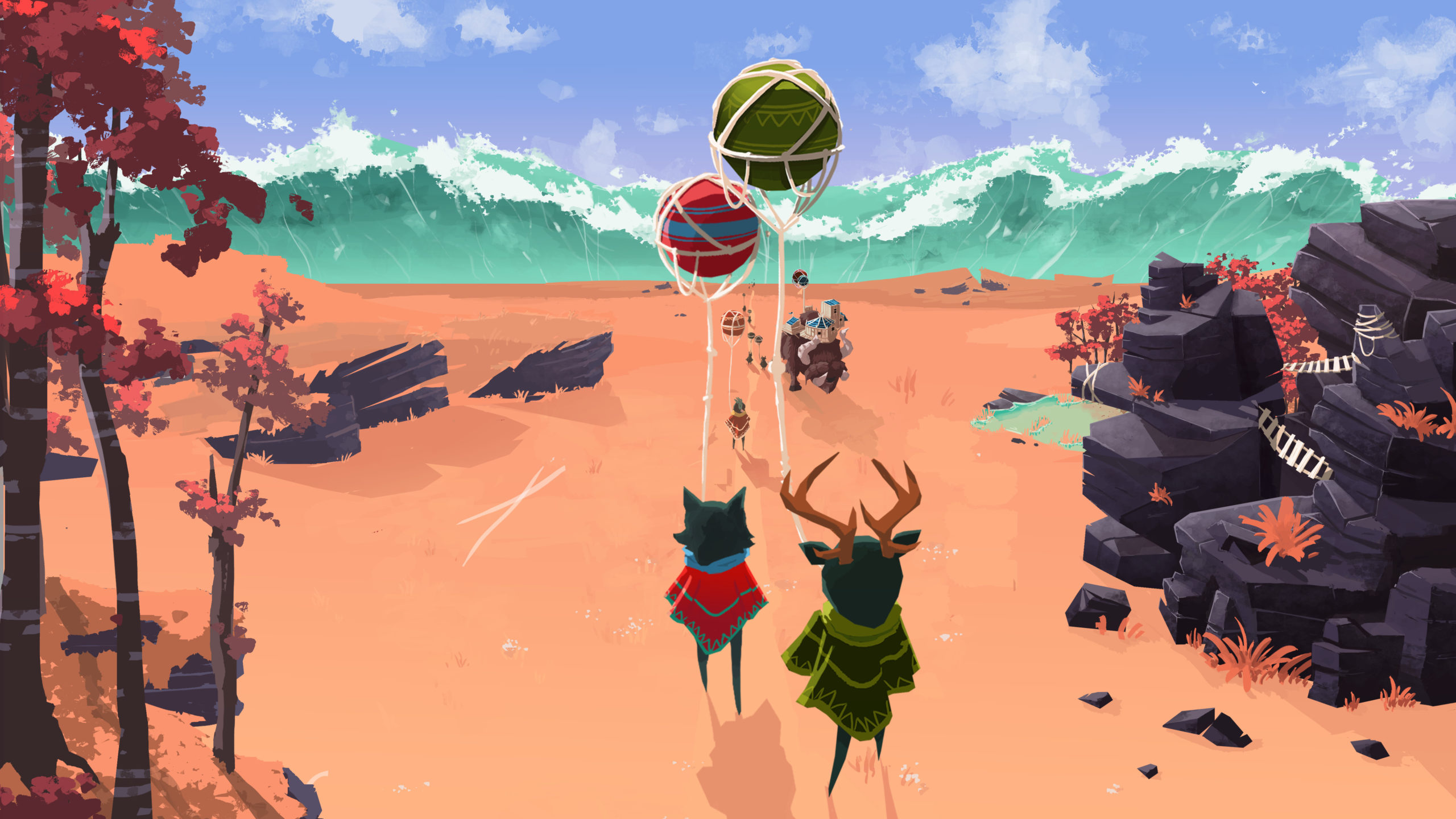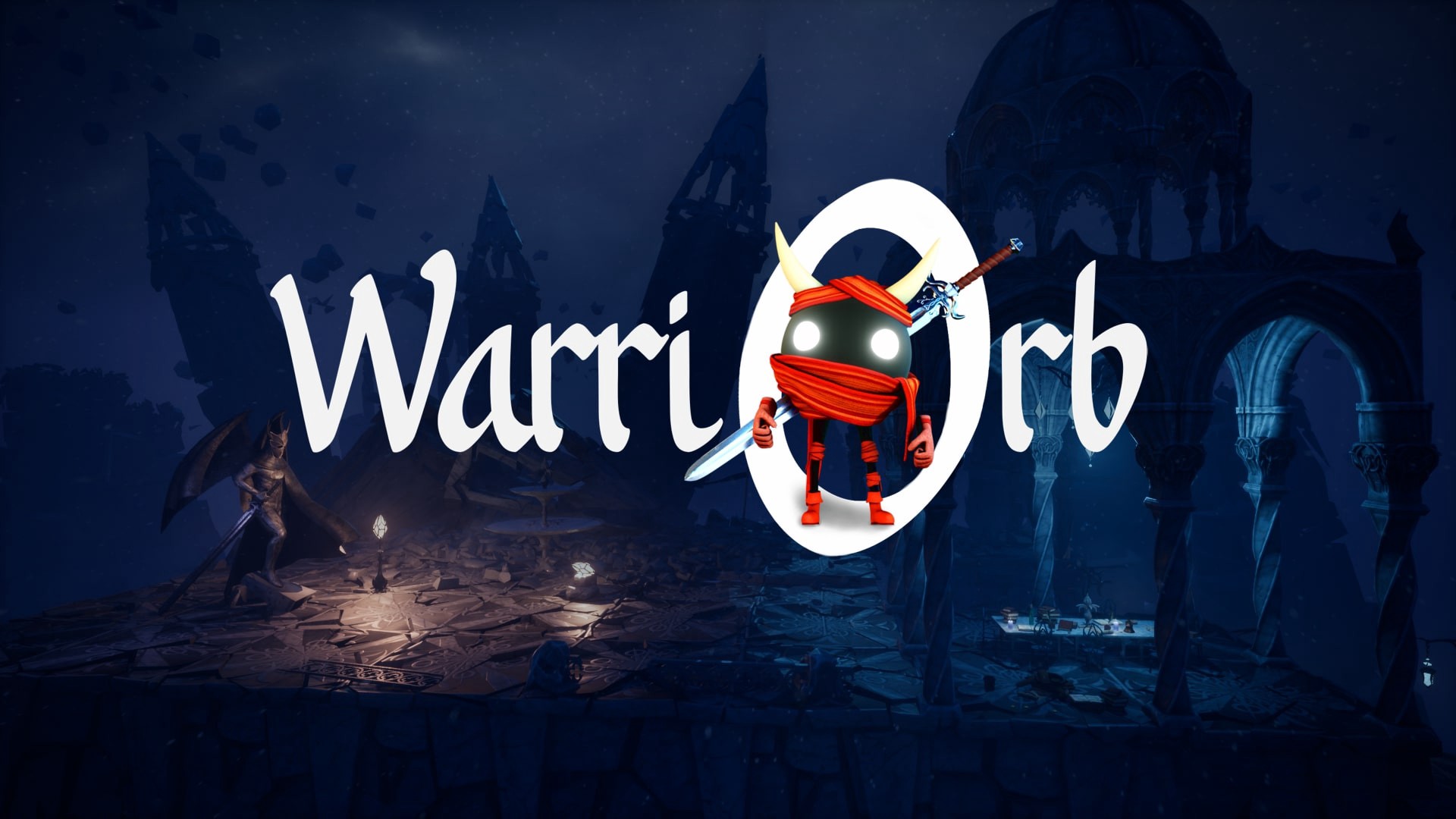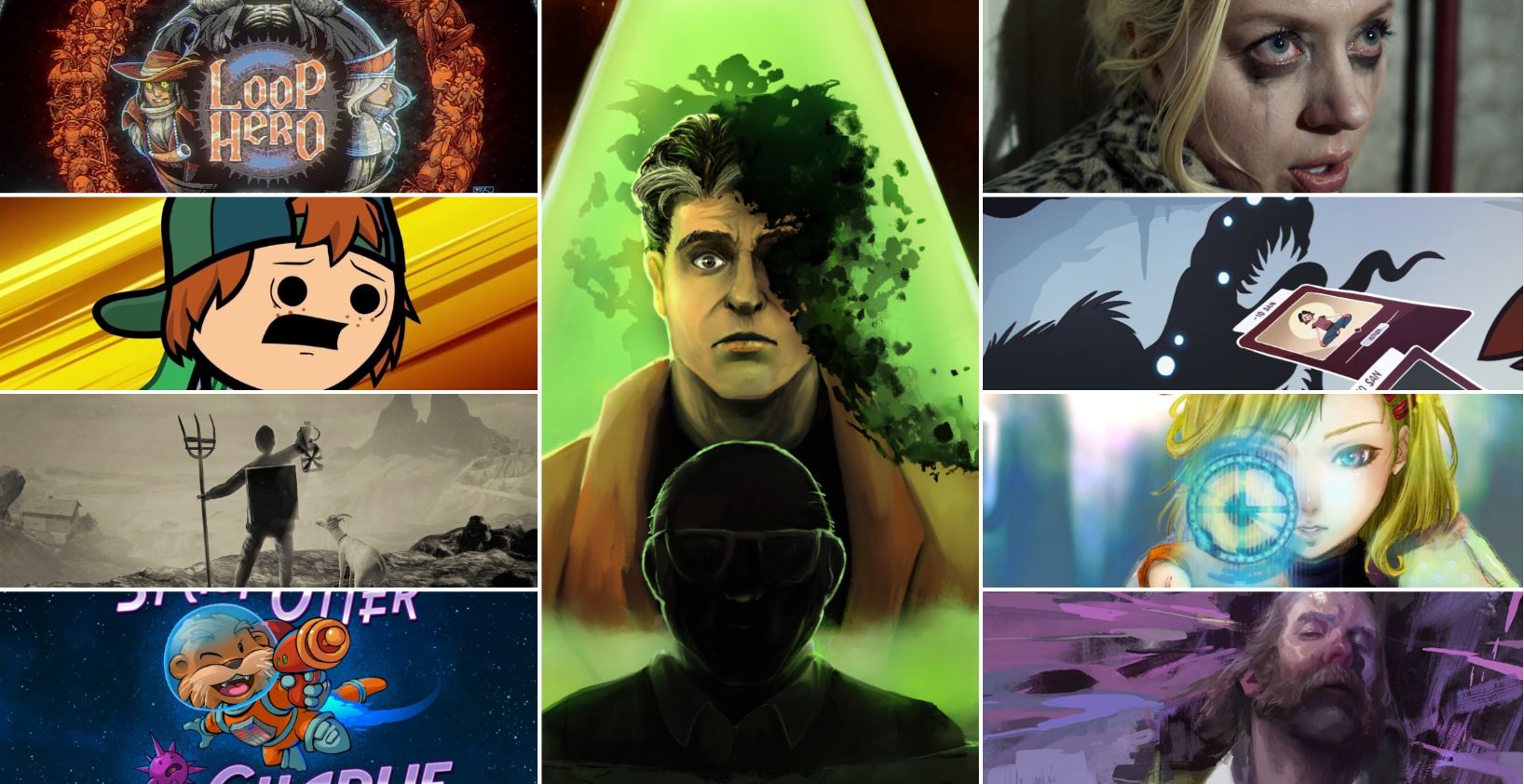As Far As The Eye (PC) Review – The Third Eye
Most management and resource-based games rely on the player establishing a base of operations – your town centre in Age of Empires, your MCV in Command and Conquer – and then staying there for the duration. One of the most satisfying parts is creating your base, setting up buildings, walls and defences where you want them, and gathering resources from the surrounding area.
But imagine changing that tried and tested premise entirely. As Far As The Eye (AFATE) is a turn-based resource management strategy game that asks instead what this genre would be like if you weren’t really able to establish a base for any length of time, and instead had to keep moving. It puts your living quarters on the back of a large Bantha-looking creature, and sets you on the path of the nomadic tribe, constantly on the move, stopping only periodically to gather resources in order to achieve the next stage of the journey. You are literally Tusken Raiders.
In AFATE’s nomadic lifestyle, you need no defences, no walls. Instead of enemies, you will race to keep ahead of the encroaching water that washes across the map should you stay in one locale for too long. It’s a remarkably different system, one that I’ve personally never seen before, and it demands a rethink in your attitude to resources and bases, and what is actually important given your new goals.
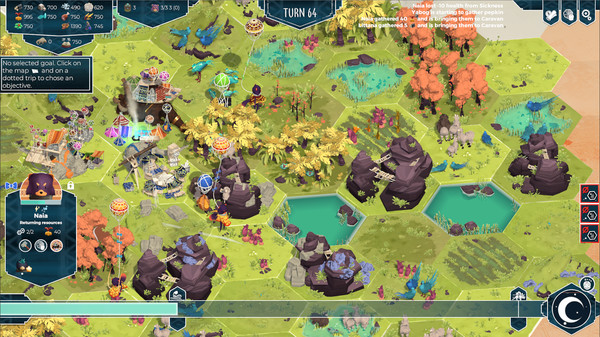
As Far As The Eye is set in a very peaceful, noncombative world populated by nomadic tribes of metamorphs (more on them in a moment). It’s a kind of romanticised Mongolian Steppe, very flat, muted pastel colours, made up of hexagonal land masses. It’s a fantasy, but it’s like a high esoteric, circle-of-life and regeneration-type fantasy, not Lord of the Rings etc. You will not find any of the tired staples here, and that’s a good thing.
And rather than a plot or story as such, As Far As The Eye offers a sandbox where the story is created by you and your tribe’s journey from where they have been settled for a short time, back to the source, The Eye. This is why it’s called As Far as The Eye. The Eye is a secluded and somewhat protected natural landmark where the tribes of this world congregate when threatened by the flood that happens every 400 or so cycles. You play as the wind itself, guiding the tribes to safety, but here the wind is a kind of benevolent god-like spirit, capable of directly managing a tribe.
The flood wave is not dealt with as an apocalyptic event either, flooding the world Noah’s Ark-style, and only the few who make it to the Eye survive. That would be a very morose and negative spin, and AFATE is all about peace and love and harmony. Instead, it’s handled in a completely positive light, a force of nature, a cyclical replenishment of the world’s resources, that admittedly, you have been harvesting and exhausting on your journey. It’s just that you need to get out of the way before it happens. There’s a reverence for the water, like it’s a holy event to be cherished, rather than scared of.
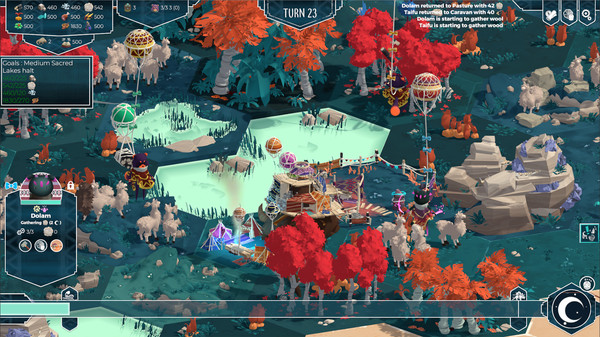
As Far As The Eye’s lore is really just a premise for your own narratives, your own journey against the elements, to unfold in. In that it pretty much succeeds, taking a backseat and letting the procedurally-generated locations, and the particular quirks and skills of your tribe make a simple story of hardship and triumph. I’m normally one who prefers dialogue-heavy, plot-filled epics with fleshed-out characters, and if you are too, then be warned, there’s very little of that here. Plot isn’t always necessary, and the management genre is one that succeeds without it more often than others.
There is a campaign mode that gives a few pupil’s names and personalises their plight a little more. However this mode is woefully short, comprising of just four levels, introducing some of the more in-depth mechanics. However much the sandbox mode doesn’t need plot, the campaign does, and this is really just a glorified tutorial, and severely lacking at that. Your tribe’s are barely three or four pupils most of the time, and the game would have benefited a lot from a few characters to engage with, and at least three times the number of campaign stages. A three-act structure of four stages each would have been perfect, and given the game the catharsis and heart its missing.
On the subject of tutorials. As you start the game you are offered campaign mode, or simply play. Choose play and you are told you have activated the tutorial, but that if this is your first time playing, we recommend doing the Campaign instead. Fine, I said, taking them at their word. I quit out and played the campaign, all four levels of it. This was all well and good, but there were a lot of logic leaps, and no explanation of controls. I worked it out, finished the campaign, and went back to start a proper run, and got the same warning. No problem, I thought, I’ve played the campaign, so I continued, and then got given the tutorial I needed earlier, the one with all the controls and basic facts. Either the tutorial should be on both modes, or at least on the campaign (where you’d normally expect it), or the game should not direct players to change modes until after they have completed the tutorial. This annoying warning text led to hours of unnecessarily difficult gameplay.
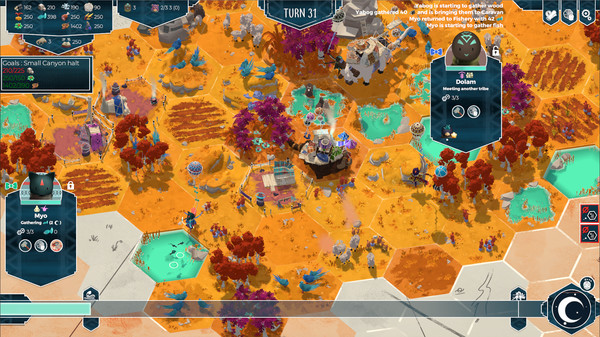
The structure of AFATE is a journey broken up into multiple halts and obstacles. The obstacles are the dotted lines between halts, that represent the hardships on the journey (labelled with the resource needs to pass). This is your goal for each stage of your journey. The halt is the resource-gathering gameplay stage that you can see on all these screenshots, the hexagons and metamorphs etc. String together multiple crossings and requirements, with multiple halts to gather resources for the next crossing, and you have a journey that goes as far as the Eye.
Each halt asks you to work out what you need to reach the next halt. The picture on the map is of the next halt, but the requirement is some invisible glacier, or broken bridge on the way. I was constantly being told about a glacier, only to arrive in a lush jungle. I really think the overworld map screen would have benefitted from a few extra points of information, such as a graphic of the glacier to cross, or the bridge that needs repairing, rather than the simple, and pretty confusing, dotted line.
The halt is where 90% of the game happens. And passing each halt is all about growing and resourcing what you need to make it over the crossing to the next halt. You only have a finite amount of time and pupils to do the work. Settle your Bantha creature and fan out looking for food deposits, game, wood and stone. You will need a dedicated building to gather anything except food, and each building can be built as a permanent structure, which you will have to leave behind, or a mobile that can be constructed on the back of another pack animal. There is a balancing-act between the cheaper cost of the permanent structure and the more expensive but mobile version. You’ll never have to pay for it again. This makes a lot of sense on those long journeys. Who knows if the next halt will have the resources you need?
There are quite a lot of resources – understandable really because there is no combat, so instead the extra resource requirements fill that space. Wood and stone are needed to build and often Ore as well. Pepkins are a kind of food source, but they don’t last long, so you can also grow cereal, or catch fish and hunt game, all of which can be cooked or else prepared into more substantial foodstuffs. Start a bakery to turn farmed cereal into rations. Rations last better and so food goes further. You also need to find pack animals to augment your caravan, and to harvest wool from. And there are a couple of more like Potions, Knowledge points, and Spices, that require your tribe to develop certain skills to use. Like a priest, yeesh.
To make things harder, food constantly depletes, losing you a certain amount every turn, and you must strike a balance between finding the required resources for the next stage of your journey, and feeding your tribe in this stage. Your pupils will die in just five turns if you run out of food, which I found out the hard way. I found in each halt that it was worth getting just enough food to function, and then focussing on the ore and wool, or whatever resource that I needed, before abandoning them (because they won’t deplete), in favour of doubling up on farms and making the more worthwhile rations. This way I was maximising my yield, specifically for the goals set by that halt.
One great part is being able to take resources with you to the next halt, but you have a finite amount of space on the back of your Bantha. Space is a premium and often needs to be used for rations and rare resources, or for the mobile buildings, which have strange shapes and fill your pack quickly. You don’t want to waste time producing too much more than you need because you can’t take much with you. Just enough to start the next halt.
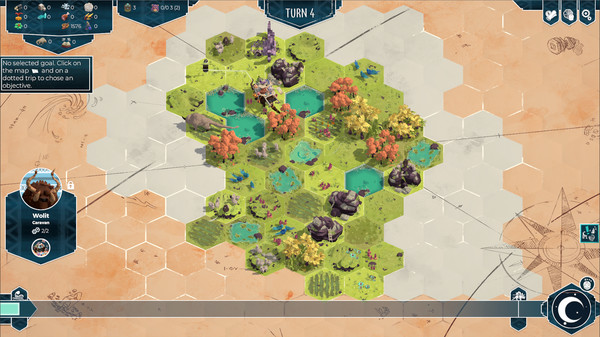
The whole setup is a fresh and interesting take on the management genre. Each procedurally-generated halt is different, each goal requirement is different, and therein lies many hours of puzzles, far more than what first meets the eye. It’s always a new challenge. How many games claim that, and don’t fulfill that promise?
Let’s talk about your tribe. You have a finite number of pupils, although there are random events where you might gain others from a neighbouring caravan. Each pupil is a metamorph. That’s got nothing to do with power rangers, it means they are capable of shapeshifting naturally into the form that best suits a particular task; pupils turn into bears to gather wood, into birds to build things, into axolotl’s to mine stone. And while that’s a nice mechanic, it makes little sense. Bird’s build nests sure, but axolotl’s mining stone? Plus a lot of them aren’t really recognisable as a particular animal.
Each pupil will show an aptitude for a particular trade, be that building, gathering, mining, whatever, and the more you make them specialise, the more they will level up. If you manage to take your caravan more than a few halts, you will start being able to use the trades upgrade wheel, which gives a nice little bonus to those specialists, making them produce more, or making them cheaper in food intake. There’s only a few levels per trade, but each has at least one evolution, and then another few levels and bonuses. It’s a nice system, but it’s not quite as extensive as it might first look.
As Far As The Eye has a relaxing feel to it, letting you take your time. The waters are always coming, but they aren’t coming yet, so relax, do some farming. This calm atmosphere is helped by a beautiful, tranquil soundtrack; lullaby piano mixed with east Asian zither-type instruments, 90s smooth jazz mixed with soft tribal sounds. It’s also dynamic, with repeated themes coming in during certain tasks, and then floating out again.
This is coupled with good sound design and a well put together ambient soundscape; the constant sound of the gentle breeze, birds chirping and crickets buzzing, wind chimes and bells in the distance. It’s like listening to one of those old environmental records they sell at zoos to help you relax while meditating and putting your faith in crystal chakras.
AFATE has no controller support at this point, so don’t bother. Get your mouse out, or your touchpad and you’re away. I generally found the controls responsive and simple to use, but didn’t always find that the interface was as intuitive as it wants to be. It was pretty rigid after being used to more freedom in other more traditional management games.
There are multiple distance ranges for the camera, from close in, to almost birds-eye view, but the touchpad swipe between them was never accurate, nor was the mouse scroll wheel. There was also more than a few cases where text went off the bottom of a screen before the sentence was over, or of untranslated French left in the English version I was playing.
AFATE is a peaceful, meditative game, that takes the resource and strategy genre and turns it on its head. It’s non-combative, and concerns itself instead with the minutiae of different resources, and actually giving you a decent goal-oriented focus within which to use them. It’s a shame that the tutorial is clunky and mishandled, and does little to cover at least a third of the different resource-types, natural disasters and obstacles you will face in the sandbox mode.
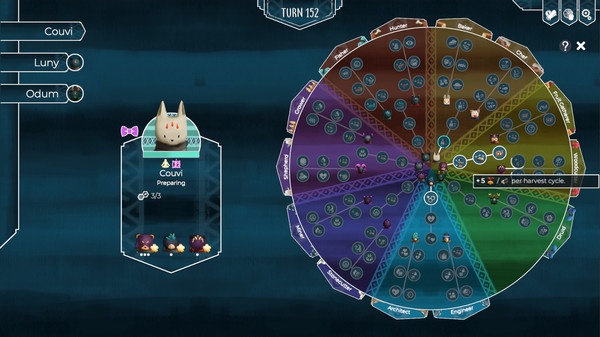
I think I like the concept, ethos and contemplative atmosphere of the game, more than I like its execution. It takes a level of patience that I do not have, and without much in the way of a campaign mode, lacks enough reward to personally keep me going. For the patient player, there is much interest to be had from all the nuances of the different systems, and discovery of the multitude of challenges the game can manufacture.
When you’re lost in the wilderness, with a flood of games coming at you this holiday season, I hope you take the time to meditate and maybe give this little indie a go.
The nomadic lifestyle translates into an interesting take on the resource and management genre, that is more interesting for its ideas than its execution. However, those who fancy a more contemplative slow going game will find solid goal-oriented challenges in this journey back to the source.
7/10
As Far As The Eye is available now on PC via Steam, GOG and Epic Store.
Developer: Unexpected
Publisher: Goblinz Studio, Maple Whispering Limited
Disclaimer: In order to complete this review we were provided with a promotional copy of the game. For our full review policy, please go here.
If you enjoyed this article or any more of our content, please consider our Patreon.
Make sure to follow Finger Guns on our social channels –Twitter, Facebook, Twitch, Spotify or Apple Podcasts – to keep up to date on our news, reviews and features.
